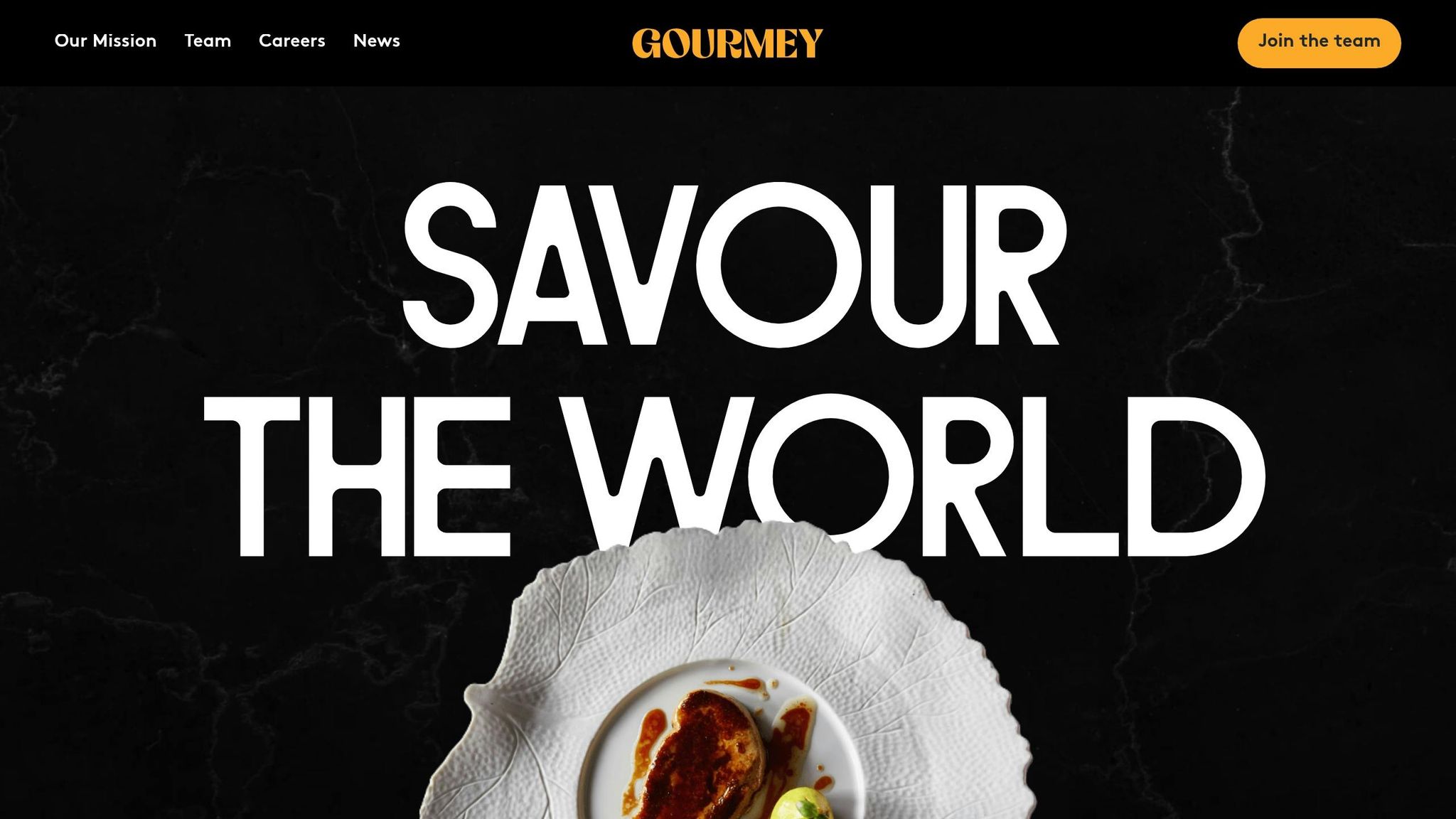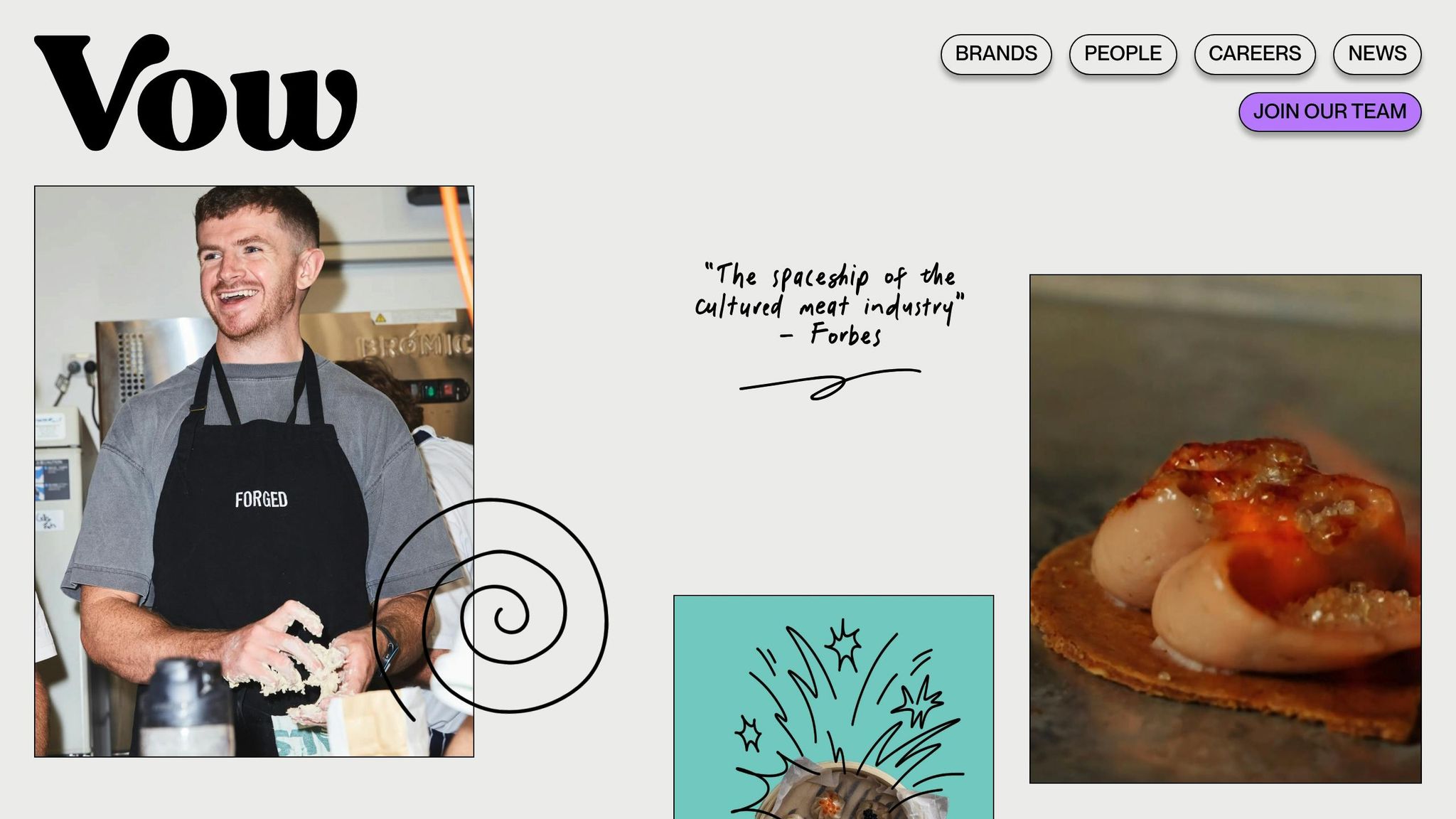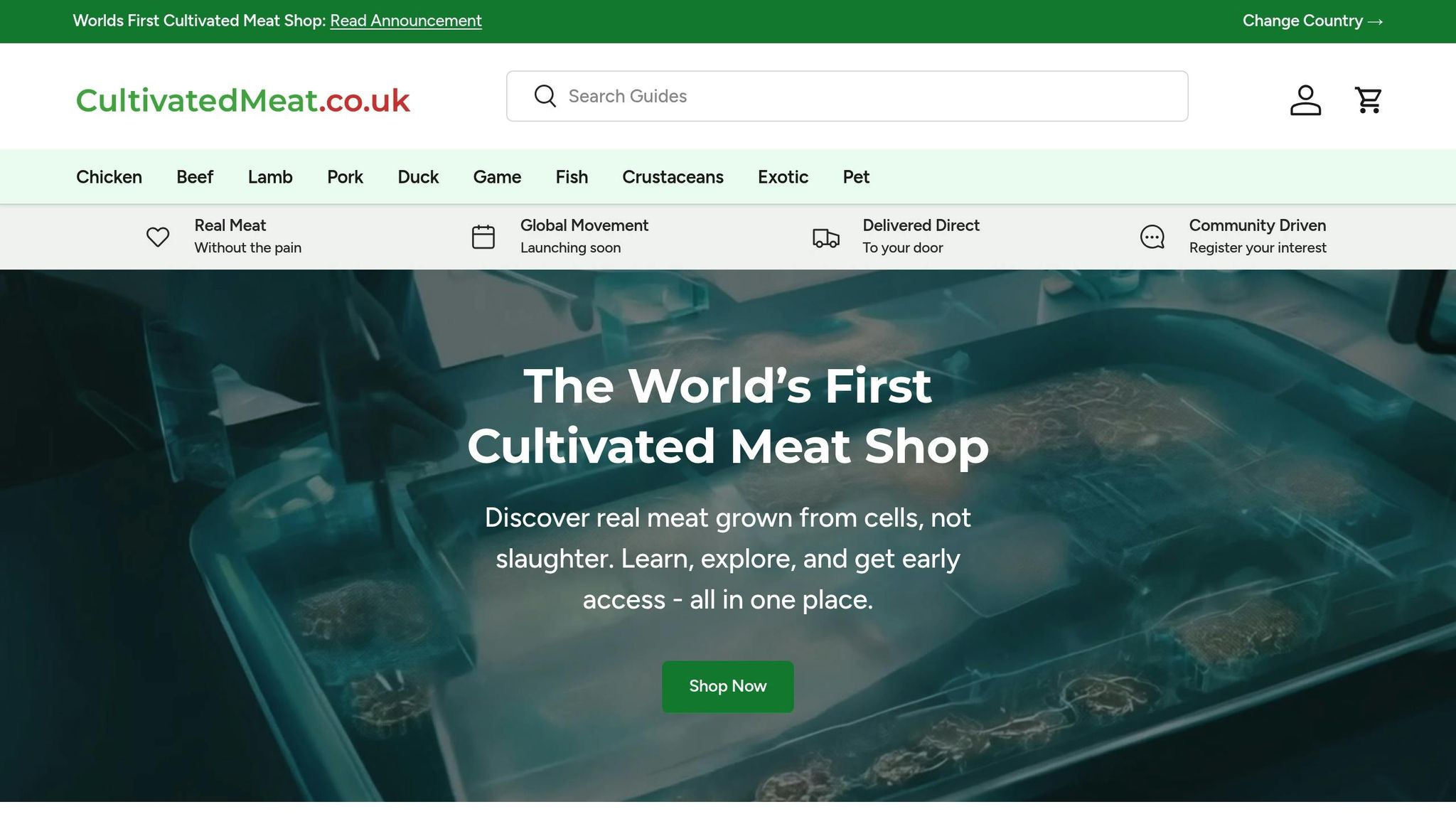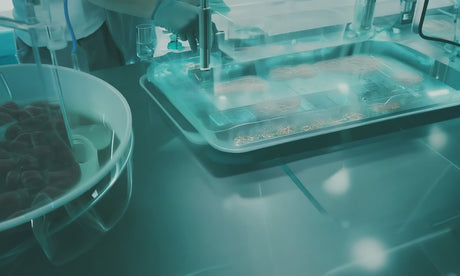Cultivated liver products are changing the way we think about gourmet foods like foie gras and pâtés. Made from animal cells grown in controlled environments, these products aim to deliver the same rich flavours without the ethical and environmental concerns tied to conventional farming. Here's what you need to know:
- Process: Animal cells are grown in bioreactors, using advanced techniques like 3D bioprinting and scaffold engineering to replicate liver texture and flavour.
- Ethics: No force-feeding or animal slaughter is involved, addressing concerns raised by 75% of French consumers unhappy with traditional foie gras methods.
- Environmental Impact: Production uses up to 80% less water, land, and CO₂ emissions compared to conventional methods.
- Challenges: High costs and consumer hesitation remain major barriers, with early products priced significantly higher than conventional options.
- Brands Leading the Way: French startup Gourmey and Australian company Vow are pioneering cultivated foie gras and liver products, targeting high-end markets with launches expected across Europe and the UK by 2026.
Cultivated liver products promise a more ethical and resource-efficient approach to luxury dining, but overcoming price and consumer acceptance hurdles will be key to their success.
How Cultivated Liver Products Are Made
The Production Process
Cultivated liver products begin with a small sample of cells, often sourced from poultry or derived from induced pluripotent stem cells (iPSCs) to ensure scalability. These cells are placed in specialised bioreactors filled with nutrient-rich solutions that promote liver cell growth. Advanced bioreactor designs, such as hollow fibre systems and fluidised bed reactors, play a critical role in ensuring nutrients reach every cell while efficiently removing waste. This stage lays the foundation for creating liver tissues with precise structural and functional characteristics.
To replicate the texture of natural liver, scaffold engineering comes into play. This process uses materials like collagen, alginate, or synthetic polymers. For example, a study in 2025 demonstrated the use of a bioink made from decellularised liver matrix, gelatin, and sodium alginate to bioprint liver tissues capable of glycogen storage and albumin production [2].
As the cells multiply, they begin to form structures that closely resemble the architecture of a natural liver. Advanced 3D bioprinting techniques, including omnidirectional printing, help organise hepatocytes into functional spheroids. These spheroids can sustain liver-specific functions for over 10 days, showcasing the potential of this technology [2].
Key Advances in Cultivated Liver Production
Recent developments have significantly advanced the production of cultivated liver products. One notable achievement is the replication of functional zonation. Researchers in 2025 successfully created lab-grown multi-zonal liver organoids, which nearly doubled the survival rates of rodents following transplantation [3].
"The research community has long needed a better model for studying human liver biology and disease. This new system paves the way for studying, and eventually treating, a wide range of otherwise fatal liver disorders."
– Dr Takanori Takebe, Director for Commercial Innovation at Cincinnati Children's Center for Stem Cell and Organoid Medicine [3]
Refining the lipid profile of cultivated liver tissues has also enhanced metabolic functions, including cytochrome P450 activity, which influences the liver's flavour and aroma. Additionally, antioxidant-enriched bioinks have been shown to increase albumin secretion five-fold and urea secretion by 2.5 times [2].
iPSC-derived liver cells, when bioprinted alongside supporting cells into hexagonal structures, demonstrate improved liver-specific gene expression and enzyme activity. Vascularisation, a crucial step, ensures that the tissue receives adequate oxygen and nutrients. This is achieved by using pre-vascularised scaffolds or inducing the formation of blood vessels to mimic the natural tissue environment.
Innovative scaffold designs have also contributed to improved outcomes. For instance, scaffolds with 60° strut angles have been shown to enhance enzyme expression and albumin secretion, improving both the taste and texture of the cultivated liver [2].
"This discovery is exciting for multiple reasons. It shows we've taken a significant step forward in growing liver tissue in the lab that accurately mimics human liver function. While human liver organoid transplantation remains at least several years away, in the lab, these special tissues may help us find ways to prevent people from ever needing a liver transplant."
– Dr Aaron Zorn, Co-Director of Cincinnati Children's Center for Stem Cell and Organoid Medicine [3]
These advancements are shaping the future of ethical, high-quality gourmet liver products, offering a modern twist on luxury dining experiences.
Leading Cultivated Liver Products and Brands
With progress in both ethics and technology, some brands are stepping up to introduce cultivated gourmet liver products. These alternatives are reshaping fine dining while addressing ethical dilemmas and navigating regulatory hurdles.
Gourmey: Cultivated Foie Gras

French company Gourmey is leading the charge in cultivated liver innovation, focusing on cultivated foie gras crafted from duck cells for high-end cuisine. In July 2024, Gourmey became the first cultivated meat company to apply for regulatory approval in the European Union. Beyond Europe, the company has also submitted applications in Singapore, the United States, the United Kingdom, and Switzerland. They aim to bring their product to top chefs and exclusive restaurants by 2026. Supporting this vision is their 46,000-ft² (approximately 4,280 m²) production facility in Paris, designed for large-scale production.
"I was genuinely impressed. Its distinctive colour and consistent texture truly stand out at first sight. The flavour is well-balanced, and the texture maintains a delightful uniformity."
– Claude Le Tohic, Meilleur ouvrier de France (MOF) and Chef-Partner at ONE65
Vow: Forged Gras and Parfait

Australian company Vow is making waves with its cultivated liver creations, including Forged Gras and Forged Parfait, made from Japanese quail cells. In April 2024, Vow launched Forged Parfait in Singapore, followed by Forged Gras in Hong Kong - marking the first time a company has sold multiple cultivated meat products in different markets. Forged Gras consists of 51% Japanese quail cells, combined with a plant-based fat blend and corn husk flavouring, and is marketed as a premium product. Meanwhile, Vow's cultivated quail parfait is available as an £11.50 snack or part of a £143 tasting menu at six restaurants. The company claims its production costs are 20–50 times lower than its closest competitor. Regulatory approval in Australia is anticipated in April 2025, with plans to launch in Australia and New Zealand by June 2025.
"We aim to create a novel approach to gourmet dining."
– George Peppou, CEO, Vow
These innovations are not only reshaping the culinary landscape but also influencing regulatory and market strategies.
Market Availability and Regulatory Status
The regulatory journey for cultivated liver products varies significantly across regions. In Singapore and Hong Kong, Vow’s products are already available in restaurants. In the United Kingdom, cultivated products are currently undergoing evaluation within the FSA/FSS Cell Cultivated Products Sandbox, part of the government's broader food strategy. Meanwhile, the European Union’s approval process for novel foods - considered one of the most rigorous - takes at least 18 months. Gourmey’s EU application represents a major milestone for the cultivated meat sector. Surveys suggest that most Europeans are open to trying cultivated meat, provided it meets safety standards. Additionally, with traditional foie gras banned in over a dozen countries due to animal welfare concerns, cultivated alternatives have a promising market.
For updates on regulatory developments and market availability, Cultivated Meat Shop provides curated insights into the evolving landscape of cultivated liver products.
Benefits and Challenges of Cultivated Gourmet Liver
Cultivated liver products bring a mix of potential advantages and notable challenges. Looking at both sides reveals why these products hold promise but also face hurdles in reshaping the future of fine dining.
Ethics and Environmental Impact
The ethical argument for cultivated liver is hard to ignore, especially given the controversies surrounding traditional liver production. For example, foie gras production, which involves force-feeding ducks and geese, has been banned in several regions. Cultivated alternatives sidestep these ethical issues while striving to offer the same luxurious taste experience.
On top of the ethical benefits, cultivated liver addresses environmental concerns. Traditional livestock farming for organ meats consumes vast amounts of land, water, and feed while releasing significant greenhouse gas emissions. In contrast, cultivated liver is produced in controlled facilities, requiring far fewer natural resources and significantly reducing environmental impact. Additionally, this controlled setting eliminates risks like pathogen contamination or heavy metal accumulation, which can occur in conventionally sourced liver.
While these benefits are clear, market realities present a different set of obstacles.
Price and Consumer Acceptance Challenges
Despite its ethical and environmental advantages, cultivated liver faces significant market challenges. Studies show that while 61.1% of young adults aged 18–40 are aware of cultivated meat, only 33.5% are open to trying it [5]. Among alternative proteins, cultivated meat has an acceptance rate of just 6.0%, far behind plant-based meat (11.1%) and legumes (78.6%) [5].
"Reasons such as unnaturalness, food neophobia, unhealthiness, negative sensory expectations and high prices are associated with negative attitudes toward cultured meat" - Feray Gençer Bingöl and Duygu Ağagündüz, Department of Nutrition and Dietetics, Burdur Mehmet Akif Ersoy University and Gazi University [5]
Price is a major sticking point. In one survey, 72.2% of respondents cited high costs as a reason for limiting meat consumption [5]. The steep production costs of cultivated meat make price parity with traditional meat a critical goal for widespread adoption [6]. This creates a challenging cycle: high prices deter consumers, and low demand makes it harder to achieve the economies of scale needed to lower costs.
Consumer perceptions further complicate matters. Many people view cultivated products as unnatural and have concerns about their nutritional value and safety. Psychological barriers, such as food neophobia (fear of new foods) and feelings of disgust, also play a role. Acceptance tends to be higher among those with more education but decreases with age [5].
"Consumer acceptance of lab-grown meat hinges on overcoming psychological barriers and building trust in a novel food technology" - Sustainability Directory [6]
Comparison Table: Traditional vs Cultivated Liver
Here’s a quick look at how traditional and cultivated liver stack up against each other:
| Aspect | Traditional Liver | Cultivated Liver |
|---|---|---|
| Ethics | Involves animal slaughter; some methods (like foie gras) are banned in certain regions | No animal slaughter required; resolves ethical concerns |
| Environmental Impact | High land, water, and feed requirements; significant greenhouse gas emissions | Minimal land use; reduced environmental footprint through controlled production |
| Taste Profile | Strong, distinctive flavour; metallic, earthy, sometimes bitter, depending on the animal | Early products show promising taste; analysis suggests lower sourness, higher umami, and similar bitterness [7] |
| Price | Established pricing; premium in gourmet markets | High production costs remain a barrier to affordability [6] |
| Accessibility | Widely available, though some products face bans in specific regions | Limited availability; regulatory approvals are pending in most areas |
| Consumer Acceptance | Established market despite polarised opinions on taste | Low acceptance (6.0%) due to unfamiliarity and concerns [5] |
| Food Safety | Risk of contamination and heavy metal accumulation | Controlled environments ensure consistent safety standards |
This comparison underscores the challenges ahead for cultivated liver. While it offers solutions to ethical, environmental, and safety issues, consumer scepticism and high costs remain significant barriers.
"Lingering doubts about naturalness and safety could confine lab-grown meat to niche markets" - Sustainability Directory [6]
For those interested in learning more, Cultivated Meat Shop provides resources to help navigate the complexities of cultivated liver and its potential role in gourmet dining.
sbb-itb-c323ed3
The Future of Gourmet: Trends and Consumer Integration
The cultivated liver market is on the brink of transformation. With regulatory approvals gaining momentum and growing interest from consumers, cultivated liver is positioned to reshape the gourmet dining experience. These developments signal a shift towards integrating these products into everyday life.
Expected Availability in the UK and Europe
Cultivated liver products are expected to debut in the UK and Europe by 2026. French startup Gourmey, known for its cultivated foie gras, has taken a significant step by filing for regulatory approval of its cultivated duck product on 26th July 2024. This marks the first such application for cultivated meat within the EU [4][11].
The European Union’s approval process for novel foods typically spans at least 18 months, placing a potential decision around January 2026 [11]. Nicolas Morin-Forest, Gourmey’s co-founder and CEO, expressed confidence in meeting these stringent regulatory requirements:
"We look forward to continuing to work closely with the regulatory authorities to ensure full compliance with safety requirements throughout these procedures. We are confident that our products will meet these highly demanding standards, so that everyone who wants to can enjoy new gourmet experiences all around the world." [4]
In the UK, the Food Standards Agency has formally accepted Gourmey’s application. Leveraging a regulatory sandbox initiative, the agency aims to streamline the approval process for novel foods derived from cultivated meat technologies [11]. This development follows the UK’s earlier milestone in July 2024, when it became the first European country to approve cultivated meat for pet food. Gourmey plans to introduce its cultivated foie gras to chefs and fine-dining establishments by 2026 [4]. This strategy aligns with how companies like UPSIDE Foods and GOOD Meat rolled out their cultivated chicken products in select restaurants across San Francisco and Washington D.C. following USDA approval in 2023 [10].
New Trends in Gourmet Applications
Advances in 3D printing and bioprocessing are revolutionising how cultivated liver is integrated into gourmet cuisine. These technologies enable chefs to experiment with intricate shapes and textures that traditional liver products cannot replicate, while also offering precise control over nutritional content [9][10].
Luxury retailers are also exploring creative uses for cultivated meat technologies. With advancements in cell culture techniques, producers can refine flavours, enhancing the umami profile and minimising any metallic or bitter aftertastes [10]. Additionally, hybrid products - a blend of cultivated liver and plant-based ingredients - are emerging as a solution to improve taste, nutrition, and affordability. These hybrids could appeal to consumers hesitant about fully cultivated products while maintaining the gourmet appeal.
High-end restaurants are expected to play a pivotal role in introducing cultivated liver to the market. By showcasing these products, they can help legitimise their place in fine dining and highlight their culinary possibilities [10].
Cultivated Meat Shop as a Consumer Resource

As the cultivated meat market evolves, consumer education becomes increasingly important. Cultivated Meat Shop has positioned itself as a key resource, offering educational materials, product previews, and waitlist sign-ups to prepare UK consumers for the arrival of cultivated liver.
The platform provides clear answers to common questions about safety, nutritional value, and production methods. This is particularly relevant as younger generations show significant interest in cultivated meat - 88% of Gen Z and 85% of Millennials are open to trying these products [8].
Regular updates on regulatory progress, product launches, and industry milestones keep consumers informed. For example, the European market for plant-based and cultivated meat is projected to grow to £13.7 billion by 2033, with a compound annual growth rate of 15.34% from 2026 [9]. The site also helps demystify terminology and labelling, noting that "cultivated" is the preferred term, supported by government-approved labels [8][10].
Conclusion
Cultivated liver products are reshaping the world of gourmet dining by blending forward-thinking technology with ethical considerations, all while maintaining the high standards of premium quality.
These products bring practical advantages too, requiring significantly less land, water, and energy, and lowering the risks of contamination [1][12].
What’s more, Mosa Meat predicts that cultivated meat could eventually be priced around €1 in supermarkets, making it a cost-effective alternative to traditional meat within the next decade [1]. This potential affordability, paired with growing interest - particularly among younger consumers - sets the stage for cultivated liver products to become a mainstream choice.
Cultivated Meat Shop is here to guide you through this exciting journey, offering trusted insights into this rapidly evolving space.
As technology and regulations continue to advance, cultivated liver products are poised to transition from novelty to everyday culinary essential. Visit Cultivated Meat Shop to stay ahead and embrace this new chapter in dining.
FAQs
How do cultivated liver products taste and feel compared to traditional options like foie gras?
Cultivated liver products, such as cultivated foie gras, aim to mirror the rich, creamy texture and refined flavour of traditional versions. Initial feedback indicates that the taste and texture are nearly identical to the conventional option.
What makes cultivated liver unique is the way it’s produced. Unlike traditional methods, it doesn’t involve force-feeding or slaughtering animals. This process tackles ethical concerns head-on while still providing a luxurious dining experience. For food enthusiasts, it’s a more considerate and sustainable choice that doesn’t sacrifice quality.
What are the ethical and environmental advantages of choosing cultivated liver over traditional options?
Choosing cultivated liver presents a powerful way to address animal welfare concerns, as it reduces the need for animal slaughter and significantly minimises suffering. For those who value humane practices, it provides a guilt-free option while still offering the rich taste and quality associated with traditional liver products.
From an environmental perspective, cultivated liver production is a game changer. It requires far less land and water, produces fewer greenhouse gas emissions, and sidesteps the pollution typically caused by conventional livestock farming. This method represents a step towards a more responsible and eco-conscious food system, helping to lower the environmental footprint of meat production and paving the way for a more sustainable future.
What are the main challenges in making cultivated liver products affordable and appealing to consumers?
The journey to making cultivated liver products both affordable and appealing comes with its fair share of hurdles. Two major challenges stand out: lowering production costs and addressing how consumers perceive these products.
Right now, producing cultivated liver is a complex and energy-intensive process, which makes it pricier than traditional liver options. To compete with conventional products, companies need to find ways to cut costs. This could mean developing better technology and scaling up production to make the process more efficient.
On the other hand, consumer acceptance is just as crucial. Some people might see cultivated liver as "unnatural" or worry about its safety, taste, or texture. To change these perceptions, companies must focus on delivering high-quality products, being open about how they're made, and educating people on their benefits - like reducing environmental impact and improving animal welfare.












